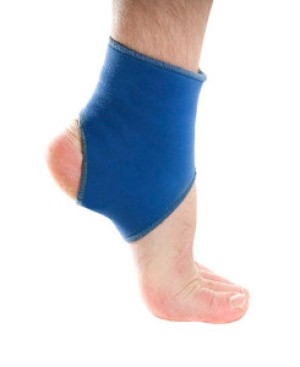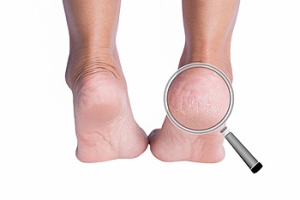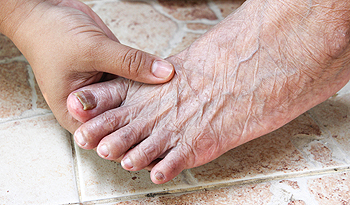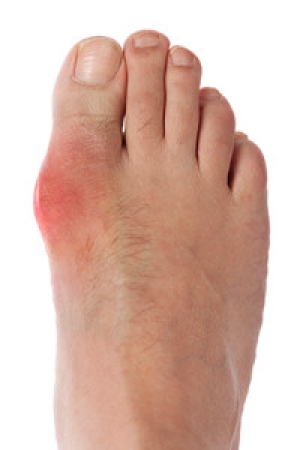Connect With Us
Featured Articles

Have I Sprained My Ankle?
Ankle sprains are a fairly common injury to the rubber band-like ligaments that connect and hold the ankle bones together. Not all ankle sprains are the same. Severity depends upon how many ligaments are affected, and whether they are overly stretched, or partially/fully torn. Having weak ankles, running on uneven surfaces, playing sports, wearing inappropriate shoes, and having prior ankle sprains can increase a person’s risk of spraining their ankle. Along with pain, an ankle sprain may cause bruising, swelling, stiffness, soreness and even difficulty walking. If your ankle does not heal properly, it could lead to future ankle sprains and chronic ankle instability. Sometimes an ankle sprain will occur along with another type of foot or ankle injury that should be addressed as well. To avoid these problematic situations, contact a podiatrist if you believe you have sprained your ankle.
Ankle sprains are common but need immediate attention. If you need your feet checked, contact Dr. Rouder from S.I. Podiatry. Our doctor can provide the care you need to keep you pain-free and on your feet.
How Does an Ankle Sprain Occur?
Ankle sprains take place when the ligaments in your ankle are torn or stretched beyond their limits. There are multiple ways that the ankle can become injured, including twisting or rolling over onto your ankle, putting undue stress on it, or causing trauma to the ankle itself.
What Are the Symptoms?
- Mild to moderate bruising
- Limited mobility
- Swelling
- Discoloration of the skin (depending on severity)
Preventing a Sprain
- Wearing appropriate shoes for the occasion
- Stretching before exercises and sports
- Knowing your limits
Treatment of a Sprain
Treatment of a sprain depends on the severity. Many times, people are told to rest and remain off their feet completely, while others are given an air cast. If the sprain is very severe, surgery may be required.
If you have suffered an ankle sprain previously, you may want to consider additional support such as a brace and regular exercises to strengthen the ankle.
If you have any questions please feel free to contact our office located in Staten Island, NY . We offer the newest diagnostic and treatment technologies for all your foot and ankle needs.
Ankle Sprains
Although ankle sprains may not be as serious as a broken ankle, they should be given immediate attention and care. An ankle sprain can lead to a significant amount of pain, as well as limited mobility. They are often characterized by the swelling and discoloration of the skin. This occurs when the ligaments are stretched beyond their limits.
The simple act of walking can sometimes cause a sprain, which makes ankle sprains a very common injury that can happen to anyone. They occur when the ankle twists in an awkward way or rolls over itself, causing a pop or snap in the tendons around the ankle. Some people are more at risk than others. These include athletes who continually push their bodies to the limits and also people who have previously suffered accidents to the feet, ankles, or lower legs.
Most of the time, an ankle sprain is not severe enough for hospital attention. There are many at-home treatment options available, including propping the leg up above your head to reduce blood flow and inflammation, applying ice packs to the affected area as needed, taking over-the-counter pain relievers and anti-inflammatory medication, using an ACE bandage to wrap and support the injured ankle, and most importantly, remaining off your feet until the ankle has fully healed.
Despite this, an ankle sprain can turn into a severe injury that might require hospitalization. If the ankle ligaments or muscles are damaged from a tear or rip, that is one sign that the sprain is severe enough for hospital attention and possibly for surgery. Even after the surgery, the recovery process can be long. You may need to have rehabilitation sessions administered by your podiatrist to get your ankle back to full health.
The severity of your sprain might become apparent if you are unable to stand or walk, consistent pain occurs over a prolonged period of time, swelling is much more severe than initially present, or if you start to experience tingling or numbness. These signs may indicate that your ankle sprain might actually be a broken ankle, an injury that requires immediate medical attention.
Although they are not completely avoidable, ankle sprains can be curbed with some preventative treatment measures. These include wearing appropriate-fitting shoes that not only provide a comfortable fit, but also ankle support. It is also recommended to stretch before doing any kind of physical activity, as this will help lower your body’s chance for an injury.
Ugly Cracked Heels
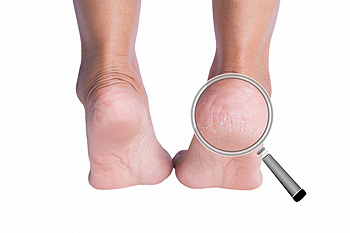 Cracked heels can be unsightly. The skin on the heel becomes dry and thickened and can even start to crack or fissure. Anyone can develop cracked heels, but it is more likely to happen to those who wear shoes with open heels (like sandals), take very hot baths or showers, use harsh soaps, have cold/dry skin, stand for long periods of time, have a physical condition such as obesity, diabetes or eczema or some deformity of the foot, like flat feet. No matter what the cause of your cracked heels are, there are steps you can take to prevent and treat them. Removing dry skin with a loofah and applying a heavy moisturizer to the bottom of the feet regularly helps. Typically, cracked heels won't cause serious health concerns, but occasionally severely cracked heels can get infected and lead to a skin infection called cellulitis. If this condition persists, it is important to see a qualified podiatrist for proper diagnosis and treatment.
Cracked heels can be unsightly. The skin on the heel becomes dry and thickened and can even start to crack or fissure. Anyone can develop cracked heels, but it is more likely to happen to those who wear shoes with open heels (like sandals), take very hot baths or showers, use harsh soaps, have cold/dry skin, stand for long periods of time, have a physical condition such as obesity, diabetes or eczema or some deformity of the foot, like flat feet. No matter what the cause of your cracked heels are, there are steps you can take to prevent and treat them. Removing dry skin with a loofah and applying a heavy moisturizer to the bottom of the feet regularly helps. Typically, cracked heels won't cause serious health concerns, but occasionally severely cracked heels can get infected and lead to a skin infection called cellulitis. If this condition persists, it is important to see a qualified podiatrist for proper diagnosis and treatment.
Cracked heels are unsightly and can cause further damage to your shoes and feet. If you have any concerns, contact Dr. Rouder from S.I. Podiatry. Our doctor can provide the care you need to keep you pain-free and on your feet.
Cracked Heels
Cracked heels appear unappealing and can make it harder for you walk around in sandals. Aside from looking unpleasant, cracked heels can also tear stockings, socks, and wear out your shoes. There are several methods to help restore a cracked heel and prevent further damage.
How Do You Get Them?
Dry skin is the number one culprit in creating cracked heels. Many athletes, walkers, joggers, and even swimmers suffer from cracked heels. Age and skin oil production play a role to getting cracked heels as well.
Promote Healing
Over the counter medicines can help, especially for those that need instant relief or who suffer from chronic dry feet.
Wear Socks – Wearing socks with medicated creams helps lock in moisture.
Moisturizers – Applying both day and night will help alleviate dryness which causes cracking.
Pumice Stones – These exfoliate and remove dead skin, which allows for smoother moisturizer application and better absorption into the skin.
Change in Diet
Eating healthy with a well-balanced diet will give the skin a fresh and radiant look. Your body responds to the kinds of food you ingest. Omega-3 fatty acids and zinc supplements can also revitalize skin tissue.
Most importantly, seek professional help if unsure how to proceed in treating cracked heels. A podiatrist will help you with any questions or information needed.
If you have any questions, please feel free to contact our office located in Staten Island, NY . We offer the newest diagnostic and treatment technologies for all your foot care needs.
Solutions for Cracked Heels
Cracked heels can make life very frustrating and embarrassing when displaying the bare feet. Aside from being unpleasing to the eye, they can also tear stockings and socks and wear out shoes at a faster rate. When severe, cracked heels may cause pain or infection.
Cracked heels are a problem for those who are athletic, those who may walk a lot, and those who have especially dry skin. Those who use medication that dry the skin, those who swim often, wearing certain types of shoes, and those who are diabetic may have trouble with cracked heels. Seniors whose skin produces less oil may also have trouble with cracked feet. There is no one way to develop cracked feet, and there is no cure.
Today, the market consists of numerous products that have a variety of ingredients to promote healing. Some of these are over-the-counter. Others are prescribed by a doctor, especially for those who have chronic dry feet and heels.
Some doctors recommend wearing socks at night for those with rough skin. This helps further healing, and helps creams stay on longer and better absorb into the skin.
One way to alleviate dryness that causes cracked heels is by using moisturizers both day and night. Another way is to make sure the skin is clean and dry at all times. Using a pumice stone to buff away dead skin before putting on moisturizer can also help. Cracked heels will not respond to the cream unless the outer layer of skin is first removed through exfoliation. After exfoliation, lotion or ointment will be absorbed by the skin more easily.
Foods that produce healing and balance can also help the skin from within. Everything that is put into the body can either help it or hurt it. Taking supplements of omega-3 fatty acids and zinc can also be very beneficial.
Nevertheless, not all products are guaranteed to help treat cracked feet. Seeing a professional is best if other treatments options were unsuccessful. A podiatrist should be able to give the best advice to help with this problem.
Arthritis Can Cause Pain in the Feet and Ankles
When Is Toenail Surgery an Option?
Many rheumatoid arthritis sufferers find that ingrown toenails have become an ongoing problem. An ingrown toenail occurs when the outer edge of the nail gets embedded in the surrounding skin. This can cause pain, swelling, and possibly an infection. If this happens regularly, surgery to remove the nail may be an option to consider. If you still have a good blood supply to the feet and toes, and if you are not currently having a rheumatoid flare-up, removal of the toenail is a viable option. Surgery, which can be carried out by a podiatrist, is a long-term solution. But it’s important to remember that because of rheumatoid arthritis the healing process may be slow. Other options can include changing your footwear to a larger size and seeing a podiatrist to set up a series of regular foot-care appointments as a preventative measure.
Ingrown toenails may initially present themselves as a minor discomfort, but they may progress into an infection in the skin without proper treatment. For more information about ingrown toenails, contact Dr. Rouder of S.I. Podiatry. Our doctor can provide the care you need to keep you pain-free and on your feet.
Ingrown Toenails
Ingrown toenails are caused when the corner or side of a toenail grows into the soft flesh surrounding it. They often result in redness, swelling, pain, and in some cases, infection. This condition typically affects the big toe and may recur if it is not treated properly.
Causes
- Improper toenail trimming
- Genetics
- Improper shoe fitting
- Injury from pedicures or nail picking
- Abnormal gait
- Poor hygiene
You are more likely to develop an ingrown toenail if you are obese, have diabetes, arthritis, or have any fungal infection in your nails. Additionally, people who have foot or toe deformities are at a higher risk of developing an ingrown toenail.
Symptoms
Some symptoms of ingrown toenails are redness, swelling, and pain. In rare cases, there may be a yellowish drainage coming from the nail.
Treatment
Ignoring an ingrown toenail can have serious complications. Infections of the nail border can progress to a deeper soft-tissue infection, which can then turn into a bone infection. You should always speak with your podiatrist if you suspect you have an ingrown toenail, especially if you have diabetes or poor circulation.
If you have any questions, please feel free to contact our office located in Staten Island, NY . We offer the newest diagnostic and treatment technologies for all your foot care needs.
Ingrown Toenails
An ingrown toenail is a nail that has curved downward and grown into the skin. This typically occurs at either the nail borders or the sides of the nail. As a result, pain, redness, swelling, and warmth may occur in the toe. If a break in the skin forms due to the ingrown nail, bacteria may enter and cause an infection in the area; this is typically characterized by a foul odor and drainage.
Ingrown toenails have multiple reasons for developing. In many instances, the condition is a result of genetics and is inherited. The most common cause, however, is improper trimming; cutting the toenails too short forces the skin beside the nail to fold over. An ingrown toenail can also develop due to trauma, such as stubbing the toe, having an object fall on the toe, or participating in activities that involve repeated kicking or running. Wearing shoes that are too tight or too short can also cause ingrown toenails.
Treatment for an ingrown toenail varies between patients and the severity of the condition. In most cases, it is best to see your podiatrist for thorough and proper treatment. After examining your toe, your podiatrist may prescribe oral antibiotics to clear the infection if one is present. Surgical removal of either a portion of the nail or the entire nail may also be considered. In some cases, complete removal or destruction of the nail root may be required. Most patients who undergo nail surgery experience minimal pain afterward and can return to normal activity the following day.
Ingrown toenails can be prevented with proper nail trimming and by avoiding improper-fitting shoes. When cutting the toenails, be sure that you are cutting in a straight line and avoid cutting them too short. Shoes should not be too short or tight in the toe box.
Symptoms Of Athlete’s Foot
 One of the most common fungal infections that affects the feet, is known as athlete’s foot. The symptoms that are associated with this condition may consist of skin that is red and itchy, and often appears between the toes or on the bottom of the feet. The technical name for this condition is known as tinea pedis, but most people refer to it as athlete’s foot. This contagious fungus is typically found in warm, humid, and wet environments, and may live on public shower room floors or in swimming pools and surrounding areas. If this ailment is managed promptly, the symptoms may not be as severe. If too much time elapses before proper treatment can begin, the uncomfortable symptoms may include bleeding from cracked skin, thick or discolored toenails, or an unpleasant odor emanating from the affected foot. Please consider consulting with a podiatrist for a correct diagnosis.
One of the most common fungal infections that affects the feet, is known as athlete’s foot. The symptoms that are associated with this condition may consist of skin that is red and itchy, and often appears between the toes or on the bottom of the feet. The technical name for this condition is known as tinea pedis, but most people refer to it as athlete’s foot. This contagious fungus is typically found in warm, humid, and wet environments, and may live on public shower room floors or in swimming pools and surrounding areas. If this ailment is managed promptly, the symptoms may not be as severe. If too much time elapses before proper treatment can begin, the uncomfortable symptoms may include bleeding from cracked skin, thick or discolored toenails, or an unpleasant odor emanating from the affected foot. Please consider consulting with a podiatrist for a correct diagnosis.
Athlete’s foot is an inconvenient condition that can be easily reduced with the proper treatment. If you have any concerns about your feet and ankles, contact Dr. Rouder from S.I. Podiatry. Our doctor will treat your foot and ankle needs.
Athlete’s Foot: The Sole Story
Athlete's foot, also known as tinea pedis, can be an extremely contagious foot infection. It is commonly contracted in public changing areas and bathrooms, dormitory style living quarters, around locker rooms and public swimming pools, or anywhere your feet often come into contact with other people.
Solutions to Combat Athlete’s Foot
- Hydrate your feet by using lotion
- Exfoliate
- Buff off nails
- Use of anti-fungal products
- Examine your feet and visit your doctor if any suspicious blisters or cuts develop
Athlete’s foot can cause many irritating symptoms such as dry and flaking skin, itching, and redness. Some more severe symptoms can include bleeding and cracked skin, intense itching and burning, and even pain when walking. In the worst cases, Athlete’s foot can cause blistering as well. Speak to your podiatrist for a better understanding of the different causes of Athlete’s foot, as well as help in determining which treatment options are best for you.
If you have any questions please feel free to contact our office located in Staten Island, NY . We offer the newest diagnostic and treatment technologies for all your foot and ankle needs.
Athlete’s Foot
Athlete’s foot, or tinea pedis, is a skin disease caused by a fungal infection. The infection typically occurs between the toes, and the feet are most subject to this disease because shoes best create the warm, dark, and moist environment in which fungus thrives. Other areas that create a similar environment, such as swimming pools, public showers, and locker rooms; can also promote fungi growth.
Symptoms of athlete’s foot include dry skin, itching, scaling, inflammation, and blistering. Sometimes, blisters can evolve into the cracks or breaks in the skin. The exposed tissue can then create pain, swelling, and discharge. The spread of infection can cause itching and burning as well.
While athlete’s foot commonly occurs between the toes, it may also spread to the toenails or soles of the feet. Other parts of the body, such as the groin or underarms, can also become infected if they are touched after the original area of infection is scratched. Aside from physical contact, athlete’s foot can also spread through the contamination of footwear, clothing or bedsheets.
Proper foot hygiene is essential in preventing athlete’s foot. You can prevent the fungus from spreading by frequently washing your feet using soap and water, thoroughly drying the feet between the toes, changing shoes and socks every day to reduce moisture, and ensuring that bathroom and shower floors are disinfected. Other tips include using shower shoes, avoiding walking barefoot in public environments, wearing light and airy shoes, and wearing socks that keep the feet dry.
While treatment for athlete’s foot can involve topical or oral antifungal drugs, mild cases of the infection can be treated by dusting foot powder in shoes and socks. Any treatment used can be supplemented by frequently bathing the feet and drying the toes. If proper foot hygiene and self-care do not ease your case of athlete’s foot, contact your podiatrist. He will determine if the underlying cause of your condition is truly a fungus. If that is the case, a comprehensive treatment plan may be suggested with the inclusion of prescription antifungal medications.
What Is Gout Caused By?
 If the joint surrounding your big toe becomes inflamed and irritated, you may have a condition that is known as gout. Gout is considered to be a form of arthritis and typically causes severe pain and discomfort. Many patients experience gout attacks, which can occur suddenly and can last for extended periods of time. Some of the symptoms that are associated with gout may include heat emanating from the affected toe, redness, and swelling. Gout is generally caused by a condition that is known as hyperuricemia. This is the medical term given when there is excess uric acid in the blood levels. Uric acid comes from purines, which can be found in certain foods. If there is too much uric acid in the body, crystals may form in the joints of the big toe. This causes gout to develop. Gout can be managed when certain lifestyle changes are made, including making healthy eating choices and following a light exercise program. If you have gout, it may be considered to speak to a podiatrist.
If the joint surrounding your big toe becomes inflamed and irritated, you may have a condition that is known as gout. Gout is considered to be a form of arthritis and typically causes severe pain and discomfort. Many patients experience gout attacks, which can occur suddenly and can last for extended periods of time. Some of the symptoms that are associated with gout may include heat emanating from the affected toe, redness, and swelling. Gout is generally caused by a condition that is known as hyperuricemia. This is the medical term given when there is excess uric acid in the blood levels. Uric acid comes from purines, which can be found in certain foods. If there is too much uric acid in the body, crystals may form in the joints of the big toe. This causes gout to develop. Gout can be managed when certain lifestyle changes are made, including making healthy eating choices and following a light exercise program. If you have gout, it may be considered to speak to a podiatrist.
Gout is a foot condition that requires certain treatment and care. If you are seeking treatment, contact Dr. Rouder from S.I. Podiatry. Our doctor will treat your foot and ankle needs.
What Is Gout?
Gout is a type of arthritis caused by a buildup of uric acid in the bloodstream. It often develops in the foot, especially the big toe area, although it can manifest in other parts of the body as well. Gout can make walking and standing very painful and is especially common in diabetics and the obese.
People typically get gout because of a poor diet. Genetic predisposition is also a factor. The children of parents who have had gout frequently have a chance of developing it themselves.
Gout can easily be identified by redness and inflammation of the big toe and the surrounding areas of the foot. Other symptoms include extreme fatigue, joint pain, and running high fevers. Sometimes corticosteroid drugs can be prescribed to treat gout, but the best way to combat this disease is to get more exercise and eat a better diet.
If you have any questions please feel free to contact our office located in Staten Island, NY . We offer the newest diagnostic and treatment technologies for all your foot and ankle needs.
